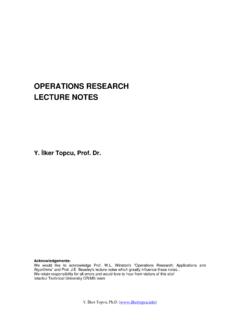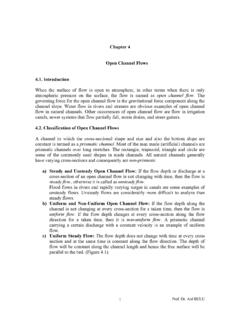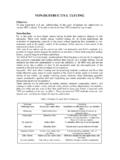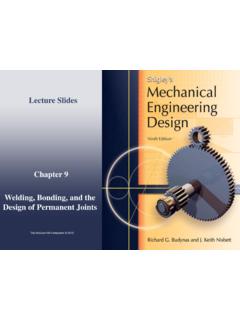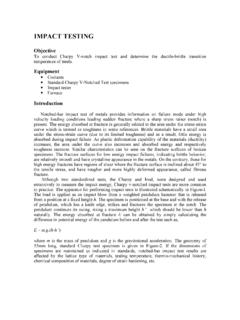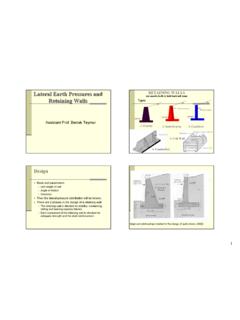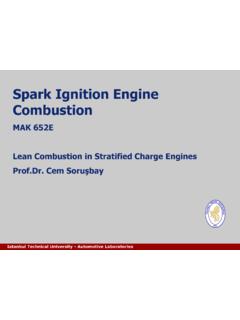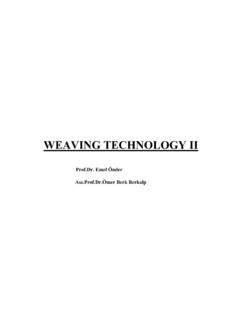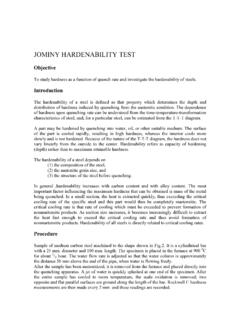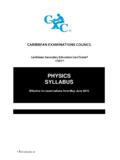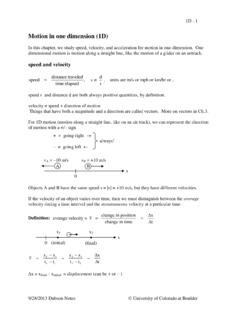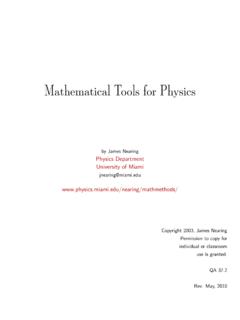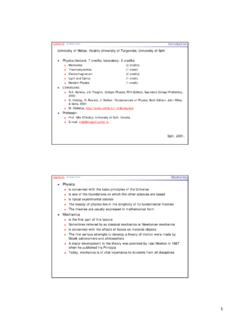Transcription of OPERATIONS RESEARCH LECTURE NOTES - Anasayfa
1 Y. lker Topcu, ( ) OPERATIONS RESEARCH LECTURE NOTES Y. lker Topcu, Prof. Dr. Acknowledgements: We would like to acknowledge Prof. Winston's " OPERATIONS RESEARCH : Applications and Algorithms" and Prof. Beasley's LECTURE NOTES which greatly influence these We retain responsibility for all errors and would love to hear from visitors of this site! Istanbul Technical University OR/MS team Y. lker Topcu, ( ) i CONTENTS 1. INTRODUCTION TO OR .. 1 TERMINOLOGY .. 1 THE METHODOLOGY OF OR .. 1 HISTORY OF OR .. 2 2. BASIC OR CONCEPTS.
2 6 3. LINEAR PROGRAMMING .. 11 FORMULATING LP .. 13 Giapetto Example .. 13 Advertisement Example .. 14 Diet Example .. 15 Post Office Example .. 16 Sailco Example .. 16 Customer Service Level Example .. 17 SOLVING LP .. 19 LP Solutions: Four 19 The Graphical Solution .. 19 The Simplex Algorithm .. 24 The Big M Method .. 30 DUALITY .. 33 Primal Dual .. 33 Finding the Dual of an LP .. 33 The Dual 35 Economic Interpretation .. 36 SENSITIVITY ANALYSIS .. 38 Reduced 38 Shadow Price .. 38 Conceptualization .. 38 Utilizing Lindo Output for Sensitivity.
3 39 Some important equations .. 40 Utilizing Simplex for Sensitivity .. 41 Duality and Sensitivity Analysis .. 43 The 100% Rule .. 43 Y. lker Topcu, ( ) ii 4. TRANSPORTATION PROBLEMS .. 44 FORMULATING TRANSPORTATION PROBLEMS .. 44 Formulating Balanced Transportation Problem .. 45 Balancing an Unbalanced Transportation Problem .. 46 FINDING BFS FOR TRANSPORT N PROBLEMS .. 47 Northwest Corner Method .. 48 Minimum Cost Method .. 50 Vogel s Method .. 51 THE TRANSPORTATION SIMPLEX METHOD .. 53 TRANSSHIPMENT PROBLEMS .. 56 ASSIGNMENT PROBLEMS.
4 59 LP Representation .. 59 Hungarian Method .. 59 5. INTEGER PROGRAMMING .. 63 FORMULATING IP .. 64 Budgeting Problems .. 64 Knapsack Problems .. 66 Fixed Charge Problems .. 66 Membership in Specified 70 Either-Or Constraints .. 72 If-Then Constraints .. 73 Traveling Salesperson Problems .. 74 SOLVING IP .. 75 Categorization .. 75 LP Relaxation .. 76 Enumeration .. 77 The Branch-and-Bound Method .. 78 Cutting Planes .. 94 Y. lker Topcu, ( ) 1 1. INTRODUCTION TO OR TERMINOLOGY The British/Europeans refer to "operational RESEARCH ", the Americans to " OPERATIONS RESEARCH " - but both are often shortened to just "OR" (which is the term we will use).
5 Another term which is used for this field is "management science" ("MS"). The Americans sometimes combine the terms OR and MS together and say "OR/MS" or "ORMS". Yet other terms sometimes used are "industrial engineering" ("IE"), "decision science" ("DS"), and problem solving . In recent years there has been a move towards a standardization upon a single term for the field, namely the term "OR". OPERATIONS RESEARCH (Management Science) is a scientific approach to decision making that seeks to best design and operate a system, usually under conditions requiring the allocation of scarce resources.
6 A system is an organization of interdependent components that work together to accomplish the goal of the system. THE METHODOLOGY OF OR When OR is used to solve a problem of an organization, the following seven step procedure should be followed: Step 1. Formulate the Problem OR analyst first defines the organization's problem. Defining the problem includes specifying the organization's objectives and the parts of the organization (or system) that must be studied before the problem can be solved. Step 2. Observe the System Next, the analyst collects data to estimate the values of parameters that affect the organization's problem.
7 These estimates are used to develop (in Step 3) and evaluate (in Step 4) a mathematical model of the organization's problem. Y. lker Topcu, ( ) 2 Step 3. Formulate a Mathematical Model of the Problem The analyst, then, develops a mathematical model (in other words an idealized representation) of the problem. In this class, we describe many mathematical techniques that can be used to model systems. Step 4. Verify the Model and Use the Model for Prediction The analyst now tries to determine if the mathematical model developed in Step 3 is an accurate representation of reality.
8 To determine how well the model fits reality, one determines how valid the model is for the current situation. Step 5. Select a Suitable Alternative Given a model and a set of alternatives, the analyst chooses the alternative (if there is one) that best meets the organization's objectives. Sometimes the set of alternatives is subject to certain restrictions and constraints. In many situations, the best alternative may be impossible or too costly to determine. Step 6. Present the Results and Conclusions of the Study In this step, the analyst presents the model and the recommendations from Step 5 to the decision making individual or group.
9 In some situations, one might present several alternatives and let the organization choose the decision maker(s) choose the one that best meets her/his/their needs. After presenting the results of the OR study to the decision maker(s), the analyst may find that s/he does not (or they do not) approve of the recommendations. This may result from incorrect definition of the problem on hand or from failure to involve decision maker(s) from the start of the project. In this case, the analyst should return to Step 1, 2, or 3. Step 7.
10 Implement and Evaluate Recommendation If the decision maker(s) has accepted the study, the analyst aids in implementing the recommendations. The system must be constantly monitored (and updated dynamically as the environment changes) to ensure that the recommendations are enabling decision maker(s) to meet her/his/their objectives. HISTORY OF OR (Prof. Beasley s LECTURE NOTES ) OR is a relatively new discipline. Whereas 70 years ago it would have been possible to study mathematics, physics or engineering (for example) at university it would not have been possible to study OR, indeed the term OR did not exist then.
